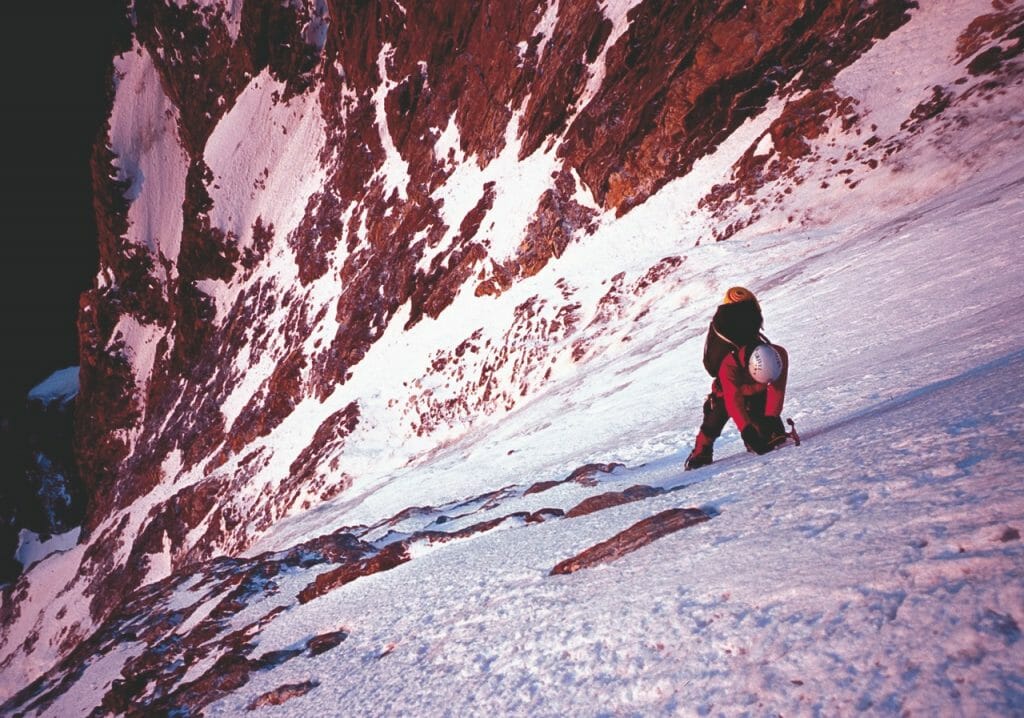Increase your performance in dangerous situations, the smart way.
Recently I shared how my early climbing experiences in Slovenia helped shape my ability to stay focused while climbing, and all that means in complex alpine environments. I call it Fuzzy Awareness*. But, as I’ve said before, this ability to think—and act—clearly and smartly in demanding and dangerous situations is critically important to us as mountain athletes. And it is virtually impossible to train in the way we know how to train our physical capacities. Or is that really the case? If you want to improve your capacity to climb or ski in dangerous situations, how do you raise your risk ceiling?
Risk, whether it be loose rock, bad weather, unstable snow, runout climbing, or just plain old hard climbing or skiing moves, can be the end of us. All of these hazards are part and parcel of the sports we do, and eventually many of us will reach the upper limit of the risk we’re willing to take, knowing full well that we want to do that climb/descent but simply won’t. Which is okay. Reflecting on my own progression and working with my Alpine Mentors group, I think I’ve been able to communicate a way to increase one’s risk ceiling.
If you are a poor risk taker, and want to improve your capacities in this arena, how do you do it?
How to Raise Your Risk Ceiling
Here’s my self-devised method for raising your risk ceiling, boiled down to five steps:
- Learn to channel Fuzzy Awareness at will.
- Assess the Risk: Take appropriate precautions based on a practical risk assessment tool.
- Do it: Challenge and execute to the best of your ability on that day.
- Rest your risk-taking behavior for a time period appropriate to the intensity of the risk taken previously.
- Repeat steps 4 and 5, gradually increasing the risk level in a way that feels right to you.
Mastery of this process is not fast and it is not easy. But it does work, remarkably, a lot like physical training. That is to say: Stress followed by rest followed by well-timed stress enables growth.
Stress + Rest + Stress = Growth
Let’s review the above steps, from the top.
1. Fuzzy Awareness
This was the subject of my post about what climbing in Slovenia taught me, so I won’t go into it in detail. But until you can channel Fuzzy Awareness on demand, the other steps are probably not going to help you much. If you’re struggling with this step, probably the most difficult part of this equation, then I recommend starting with a breath meditation practice to train your ability to concentrate. An ability to concentrate will facilitate developing greater awareness.
2. Assess the Risk
Risk assessment has been studied extensively, and it is actually a very simple, common process we can use:
- What is the chance of me [insert risk—examples: falling | triggering an avalanche | being hit by a falling rock | getting caught by a life-threatening storm]?
- What is the consequence of me [insert risk]?
- How well am I able to answer questions 1 and 2? If not well, why? (Ego, insufficient data, no weather forecast, etc.)
- Is there anything more that I am willing and able to do to protect myself and my team from [insert risk]? I say willing and able because it may be the case that you would place better gear, but you don’t want to take the time, or the rock is poor, etc.
3. Do It
Activate Fuzzy Awareness—focus without allowing any doubt to enter your mind—and execute. Almost 99.9 percent of the time, if your step up in risk-taking is appropriate to your skill level, both in the sport movement and in risk assessment, your confidence will increase.
4. Rest
Rest is a step I think is underutilized. Give your risk-taking a break. I think that we, our whole selves, the physical and mental capacities that make us climbers, need time to process what we’ve learned. This time varies from person to person and from novice through expert. But it’s individual. My suggestion is that the bigger the step was for you, the more time you need because the less it is immediately repeatable. A small but significant step up in your risk ceiling will need a month. A big step, a year. Notice I’m not talking about hours, days, or even weeks. I’m talking about real blocks of time, blocks of time long enough that the very details of the past experience become fuzzy.
5. Repeat
When you’re ready to challenge your risk-taking behavior again, you should notice a welling up of your subconscious in the affirmative. A “Yeah, let’s do that again!” But don’t rush it, this is risk, so everything has to be as right as can be for you to succeed, and survive.
Try this out and please report back to us at coach@uphillathlete.com. And remember to take necessary risks, make good decisions, and grow.
-by Uphill Athlete co-founder Steve House
*Full Disclaimer: I’ve been asked, and I have no idea if “Fuzzy Awareness” is a term I coined or, more likely, something I picked up in a book I read.

